South Africa and Rhodesia vs min. Part II
However, this approach to the protection of soldiers and civilians could not provide an adequate level of security. In addition, it was unprofitable from an economic point of view, because a cheap explosive device could disable or even destroy an armored car, the cost of which was equivalent to hundreds or thousands of mines. Thus, simultaneously with the operation of an MPV (Mine protected vehicle) class of armored vehicles, the Rhodesian and South African forces had to pay great attention to the search and destruction of mines. It is worth noting that the enormous length of the equipped highways and simple dirt roads made the search for mines extremely difficult. Sappers with hand-held mine detectors worked too long and risked ambush, and there was simply no special mine clearance equipment.
Pookie
The first Rhodesian mines' special machine was the light Pookie armored car, built in the mid-seventies. Like other South African armored vehicles of the time, the new model was named after a local animal. The word Pookie in some dialects of South Africa designates primates of the Galag family. Perhaps the appearance of the new engineer armored car reminded these little animals to someone, which influenced the choice of the project name.
The specific role of the new machine has affected its appearance. According to the authors of the project and future operators, the crew of the armored car was to consist of only one person. Thanks to this, it was possible to create a compact and well-protected armored hull with a characteristic angular shape. It is noteworthy that the bottom of the hull was made of two panels converging at an angle, but despite this, they were able to provide the driver with sufficient comfort. The case with the help of special-shaped brackets was mounted on the chassis, consisting of two separate modules. The front was as easy as possible and simplified. Of all the necessary units in it were only the steering mechanism and a simple suspension system. For maximum simplification of the design, the steering wheel inside the armored cockpit was connected to the mechanisms with the help of a shaft mounted openly, outside the hull. The rear undercarriage module was equipped with an engine and gearbox taken from a Volkswagen Käfer (“Beetle”) car, as well as a fuel tank and battery.
The layout of the Pookie machine was driven by the need to ensure minimal impact on the mines under the wheel. For this purpose, for example, in some places of the undercarriage, relatively weak sections were intentionally made, along which destruction had to take place. Also, the armored car was designed to reduce the load on the front wheels. It was assumed that this would reduce the pressure on the ground and, as a result, reduce the likelihood of mine exploding. Finally, the Pookie sapper armored vehicle received wheels unusual for such a technique. To reduce the load on the ground, Rhodesian engineers decided to use wheels with wide tires used on Formula 1 racing cars. These wheels were supposed to be pumped up to twice as little pressure as on fireballs. Due to this, the specific load on the surface fell to acceptable values. According to some reports, the Pookie armored vehicle could safely ride anti-tank mines with a pressure fuse without fear of being blown up.
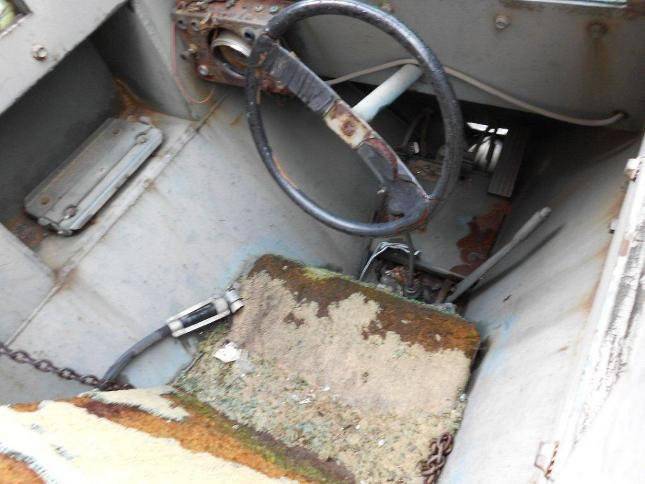
Pookie Armored Cab
With the wheels of an armored vehicle for sappers an interesting storylike a spy detective story. Since official deliveries of any components for vehicles to Rhodesia were banned, representatives of the Rhodesian industry and the army had to be incognito inculcated at the Grand Prix of South Africa. There they got acquainted with the technical staff of the teams and bought up used tires. This went on for several years and, fortunately for the Rhodesian sappers, no one guessed why such secret "contracts" were being concluded. Used tires were extensively used to equip Pookie machines, and local conditions contributed to their relatively low wear.
As a result of all the measures taken, Pookie armored cars were able to move quickly along any roads in Rhodesia at speeds up to 80 km / h and ensure the safety of convoy trucks. To search for explosive devices, the sapper machine was equipped with two metal detector frames, covered with cylindrical or box-shaped covers. They were fastened in the lower part of the hull sides and in the working position fell parallel to the ground. In the stowed position, devices for searching for mines were raised and held at an angle to the horizon.
The first two copies of the Pookie sapper armored vehicle were built in 1976. Soon, the prototypes showed all their capabilities and the army ordered five more such machines. A typical way to use this technique was as follows. In front of the convoy of vehicles and armored vehicles, an armored car with mine detectors was at a sufficient distance. Finding an explosive device, the driver-operator Pookie tagged him and drove on. Then the engineers of the column understood with a mine, and the drivers tried to drive around a dangerous object. The loss of military equipment due to the detonation of mines was significantly reduced.
However, soon the enemy noticed that the anti-tank mines had ceased to produce the expected effect and began to use improvised explosive devices, in whose construction there was no metal. It was assumed that Pookie will not be able to identify such ammunition. However, the Rhodesians responded to the enemy’s cunning with their new know-how. The equipment included a simple-structure echolocator, which allowed to find alien inclusions in the ground. It is worth noting, because of the use of this device, the armored car had to be equipped with a fairly large electronics unit, but the cost of its production was fully compensated for in just a few days of work.
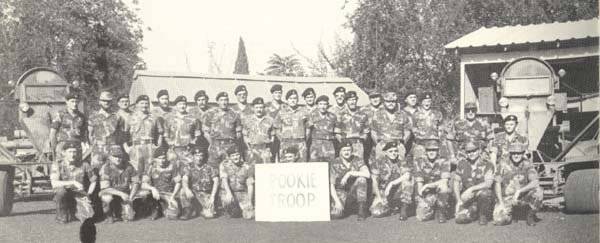
Engineering unit equipped with Pookie machines
For four years, starting with 1976, in Rhodesia, 75 Pookie-type machines were assembled, slightly differing from each other in some details of the design. For example, some of the armored cars were equipped with large wind-glass armored glass, while in others the driver had to watch the terrain through a small window. The shape of the metal detector covers and the echo sounder also changed. At the same time, regardless of the design of a specific instance, all 75 armored cars coped well with their duties. In just a few years of using the Pookie, a total of about 550 anti-tank mines and improvised explosive devices of various types have been discovered. During this time, all 12 armored cars were lost, and none of the vehicles destroyed by the enemy became a victim of mines exclusively. Most often, the engineer armored cars were ambushed and shot from grenade launchers. Fortunately, no driver died.
FU-2
The high performance of Pookie’s light armored vehicles forced the partisan sappers to change tactics. They began to mine not only roads, but also sites suitable for use as airfields. Such mining allowed solving at once two tactical tasks. Firstly, explosive devices destroyed planes taking off or landing, and secondly, the inspection of numerous improvised ground airfields took a lot of time and effort from the Rhodesian engineering units.
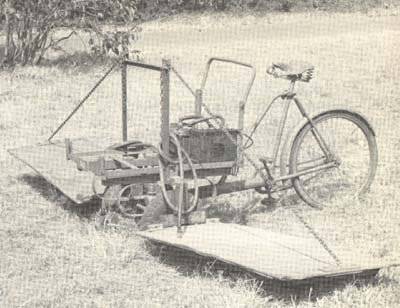
One of the options FU-2
All the Pookies that were available at that time were used to check the roads and escort the convoy, so some new type of equipment was needed. Especially for the search of mines and improvised explosive devices on large landing sites, the Rhodesian military created the simplest, but convenient and effective version of the “self-propelled mine detector” called FU-2. The basis for the new model of special equipment was the usual bike, on which a set of special equipment was mounted. Rather, part of the construction of two-wheeled transport joined the cart with the equipment and served as the workplace of the operator-driver. On a small two-wheeled cart installed battery and electronics unit. The frames of the metal detector were movably mounted on the side. Thus, at the same time one FU-2 “machine” could survey a strip of land about two meters wide.
Unfortunately, the data on this technical tool is extremely scarce and therefore, for example, it is not known exactly how the Rhodesians protected FU-2 from the risk of hitting the mine with wheels. Probably, in the front of the trolley with the equipment was another frame, watching the central sector. Despite the pronounced handicraft character, the bicycle-based mine detector proved to be quite effective and useful. Judging by the fact that the use of unprepared sites as airfields continued until the very end of the war, the sappers at FU-2 were able to find a lot of mines and save many lives. In addition, FU-2 is considered the most massive "machine" of Rhodesian sappers. According to various estimates, at least 100-150 of such systems were assembled.
Spinnekop
Spinnekop (Spider) was the last sapper armored vehicle that managed to take part in the war in Southern Rhodesia. This model, developed in South Africa, fully justified its name, because to reduce the risk of destruction, engineers raised the armored hull to the highest possible height, creating an original suspension honor. Armored housing with a characteristic V-shaped bottom divided into two compartments. In the front were the driver and operator of the mine detector. In the rear - the engine and part of the transmission units. Through the lower part of the body along the entire length of the machine, there was a frame, closed by a casing, connecting all the structural elements. In the middle part of the frame, the supports of two “skis” were fastened, which prevented the car from turning over on its side. The maximum length of the seven-toned deminer armored car Spinnekop is about seven meters. The height of the order of 3 and width, depending on the configuration, about 3,3 meter.
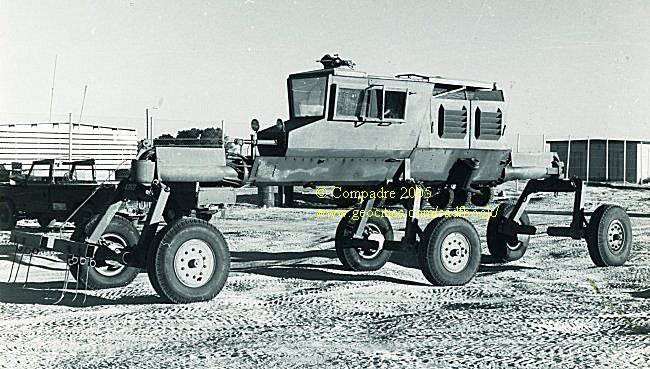
Spinnekop serial copy
In the front, middle and rear parts of the oblong frame were attached long levers, at the ends of which wheels were installed with associated systems. Because of such a sophisticated undercarriage design, the Spinnekop armored car received a hydraulic transmission. Only such a system could reliably transmit engine torque to the wheels and be located in a frame of complex construction. When using the 90-strong six-cylinder engine, the armored car could accelerate on the highway to 60 kilometers per hour. An interesting fact is that the maximum speed depended on the mode of operation of the hydraulic transmission. 60 kilometers per hour were achieved with two of the six driving wheels. When switching to the wheel formula 4х6, this figure fell to 10 km / h. Finally, in the all-wheel drive version, the Spinnekop accelerated only to 40 kilometers per hour. During the search for mines, it was recommended to move at a speed of no more than 16-18 km / h.
Spinnekop's mine detectors were mounted on a removable frame that was attached to the front wheels. According to different sources, both instrumentation using electromagnetic radiation and echolocation equipment were present in the apparatus unit. A facility operated by one of the crew members could survey a lane width of about 2,5-3 meters.
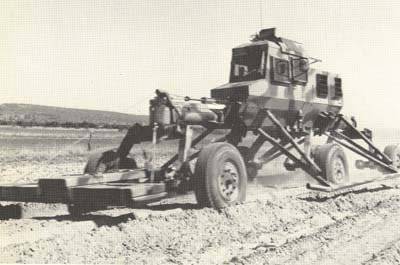
Spinnekop Mine Search Engine
It is known that the first instance of the Spinnekop sapper armored vehicle, built in 1979, was briefly tested in Rhodesia for a short time. After the tests, which showed the effectiveness of the mine detectors and the correctness of the used technical solutions, the mass production of the new armored vehicle began. In just a few years, South African industry built the entire 18 Spinnekop armored car. Such a small number of serial machines was due to the peculiarities of their use - the war ended, as a result of which the main task of the engineering units was to survey the territories in which enemy explosive devices could be located.
Ambiguous results
After the end of the war in Southern Rhodesia, all built engineer armored vehicles were divided by participants in the conflict and were actively used to clean up areas densely “planted” with anti-tank and anti-personnel mines or improvised explosive devices. At this service, most of the cars built were lost, and the few surviving copies later got into the museums of military equipment. So, one or two Pookie armored cars currently serve as museum pieces. The FU-2 mine detectors converted from bicycles, unfortunately, have been preserved only in a few poor quality photos and in the memories of those who participated in that war. Finally, a few Spinnekop machines developed their resources as part of the South African army units, after which they were written off and disposed of.
Until now, tens or even hundreds of thousands of mines and other explosive devices remain in the land of Zimbabwe and some areas of the Republic of South Africa. Demining of the territories where the fighting took place remains one of the main problems of South Africa. Nevertheless, despite the importance of the issue, the sappers of South African countries in recent decades have been forced to use the available equipment, the possibilities and effectiveness of which leave much to be desired. The main mine detection tools are still hand-held mine detectors and probes. From time to time attempts are made to build a self-propelled machine like a Pookie or Spinnekop, but they all fail. As a result, mines continue to kill people, and sappers from Zimbabwe and other poor South African states are forced to search for ammunition with outdated, inefficient systems.
On the materials of the sites:
http://rhodesians.ru/
http://shushpanzer-ru.livejournal.com/
http://armourbook.com/
http://africancrisis.org/
http://rhodesianforces.org/
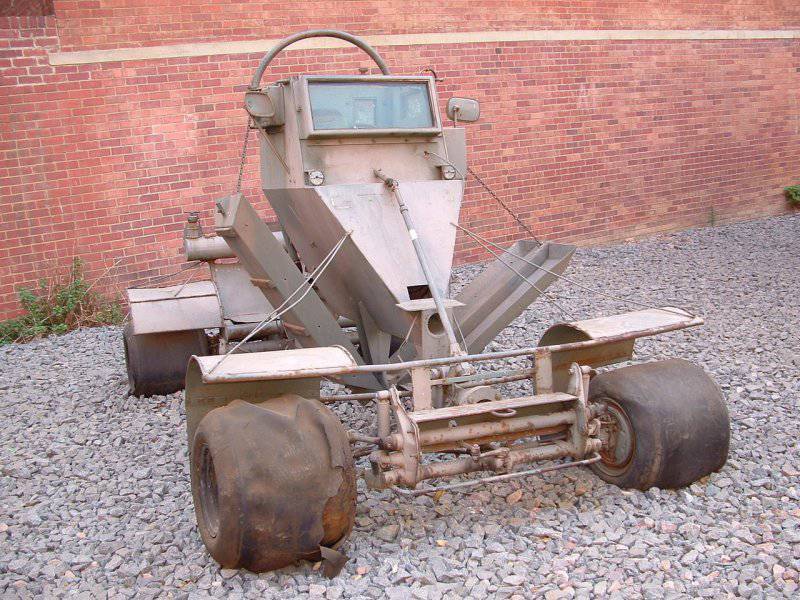
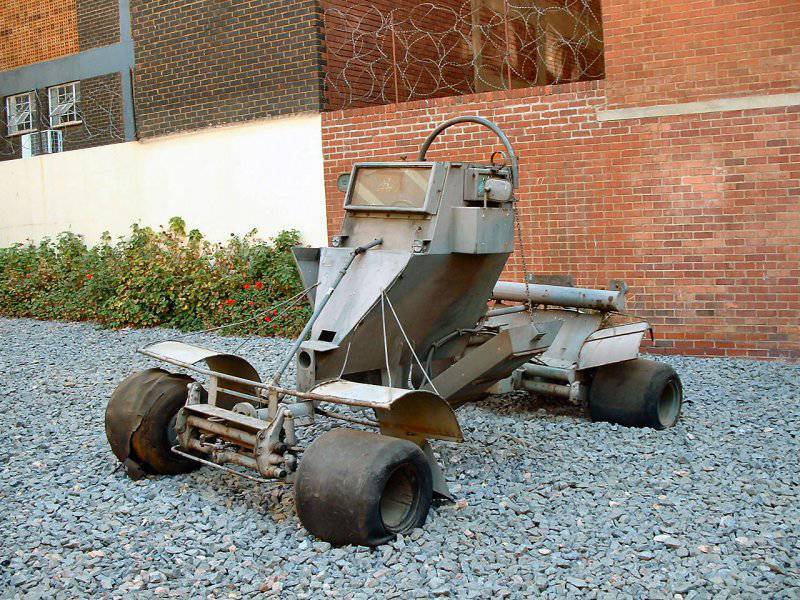
Information